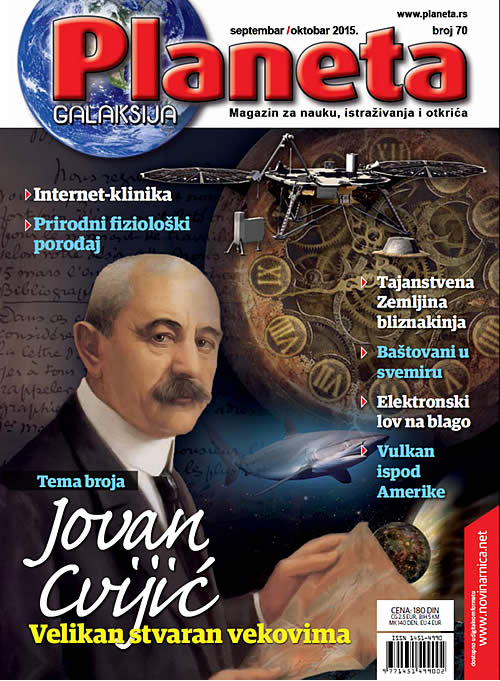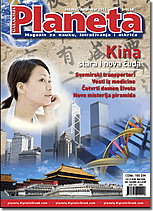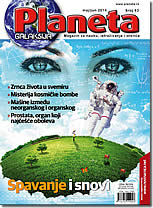| » BROJ 70 |
 |
Godina XII
Sept. - Oktob. 2015.
|
|
| » Glavni naslovi |
SUMMARY
Summary
The Topic of this Issue
Jovan Cvijić |
|
 |
This autumn it will be 150 years since the internationally renowned Serbian scientist Jovan Cvijić was born. This famous geographer and naturalist received his basic education in Serbia, and then continued his schooling in Vienna, where he took his Ph.D.in the area of morphology of the Karst region. He was a professor of geography and ethnography at the Great School in Belgrade. As a member of the Serbian Royal Academy, he was one of the first eight full professors of the Belgrade University. By the royal decree, issued in 1912, he was appointed president of the above mentioned academy. He had an honorary Ph.D. at the Paris Sorbonne and of the Karl's University of Prague. During the WW I he was employed as a representative of the Serbian government in Switzerland.
Until his death at the age of 62, he tirelessly travelled throughout the Balkans. He literally walked along the entire Balkan Peninsula, taking notes and recording with his camera everything he encountered and considered of importance for scientific areas of his engagement. That work ranked him as one of the most prominent European naturalists. His most significant works are: The Balkan Peninsula and the South Slavic Lands, Basis of Anthropogeography, Geomorphology, Ethnographic Maps of the South Slavic Lands. |
Mission of the “Down” probe
Dwarf planets - key to numerous secrets |
|
 |
The automatic spacecraft “Dawn”, launched by NASA in 2007, reached in March 2015 Ceres, the largest protoplanet of the asteroid belt located between Mars and Jupiter. Its first “stop” was the second largest asteroid of that belt - Vesta. That mission lasted for 14 months, in the years 2011 and 2012.
Ceres was discovered in 1801 by the Italian astronomer Giuseppe Piazzi, and it was named after the Roman goddess of agriculture and fertility. That tiny celestial body, of app. 1000 km diameter, which in 4,5 years completes its journey around the Sun, was originally considered a massive asteroid, however, later on it was assessed that its form was a sphere and that it had a silicate nucleus with a frozen envelope. International Astronomical Union officially included Ceres in the newly established category of “dwarf planets” in 2008.
Ceres and Vesta were chosen as two contrasting protoplanets, the first one being obviously “wet” (that is cold, with presence of ice), and the other one “dry” (that is rocky), the growth of which was disrupted by formation of the planet Jupiter. Those two bodies represent a bridge in the scientific cognition of creation of the rocky planets and of the icy bodies in the Solar System, and of the conditions under which one rocky planet can contain water. “Dawn” is the first spacecraft from Earth approaching the above mentioned two celestial bodies. |
Conquest of the Universe
Gardeners in the Space |
|
 |
Is the space salad a small bite for the man and the giant greenery for mankind? What is the meaning of the modification of the famous sentence which the American astronaut Neil Armstrong pronounced on July 29 th 1969 while stepping on the dusty soil of the Moon?
Very short track space travellers have been additionally encouraged for they crave for food they eat since they were born. However, the future gardeners on the nearby planets and satellites will find out very soon that each new inhabitation out of Earth presents a harsh place for survival. Still, in the ISS menu a sort of lettuce of a reddish colour was introduced, a one-year or two-year herbaceous plant of the family of Compositae, popular mostly for its eatable leaves .
The American corporation “Orbital Technologies” has developed a chamber (device) with flexible movable dividers that can preserve humidity, within which in extremely clean conditions vegetables can be grown in almost weightless conditions. |
Space
Methusalems of the Universe |
|
 |
Can life in Space last billions of years longer than the expected lifespan on Earth? Since scientists are discovering older and older solar systems, it is rather plausible that we will soon discover old planets in some hospitable zone.
A group of researchers, astroseismologists of the University of Birmingham in Great Britain, conveyed discovery of five tiny and lively rocky celestial bodies close to one old star. The star was named Kepler-444, after NASA's well known mission. Their contribution goes for discovery of old age of the star Kepler-444 and of the planets around her – which stands for the unbelievable 11,2 billions of years. Thus, our Solar System is almost 2,5 times younger.
Although none of those planets is suitable for life, for their orbits are too close to their star, the mere discovery of those planets presents a huge step in the quest for old hospitable celestial bodies. That life can last for billions of years is just a presumption. For what could happen if an intelligent form of life developed in a system as old as the ours, would it still be existing or would the two of them annihilate each other? |
Medicine
Obstetrics
Natural physiological delivery |
|
 |
Contemporary medicine disposes of diagnostic methods which can assess with a high percentage certainty if an individual pregnancy can end with a natural delivery. It is estimated that about 80% of women can complete their pregnancy in a way that can end with a natural physiological delivery, while 20% represent pathological pregnancies which require medical assistance. However, a number of performed caesarean sections in some countries stand at 50-70%, which presents a big disproportion. The reason behind this is inadequate attitude toward pregnancy and delivery and a widespread position that an obstetrician and not the nature should perform them.
Dr. Vladimir Vajs, gynaecologist and obstetrician of the Belgrade-based Bel Medic general hospital, advocates most strongly for the natural physiological delivery, and was one of the leading implementation agents of the pilot project of the so called non-medical delivery, recently implemented in Serbia, based on the experience of Italian doctors. It stands for the delivery process which, in case it is assessed that it is completely safe for both mother and baby, is entirely left to the nature and is not speeded up with medicaments or with doctors' interventions. Dr. Vajs explains which pregnant women are suitable for such delivery, which are the conditions a maternity hospital needs to fulfil, what preventive diagnosis needs to be performed and how such a delivery takes place. |
Energy
New sources of electricity |
|
 |
Danish island Samso became known, some ten years ago, for its energy “self- sufficiency”. A small island, 114 km2 of acreage, with a 3800 population, prevalently farmers, fulfils all aspects of its energy needs (electricity, heating of private and public buildings) exclusively from renewable energy sources (RES). In fact, the island generates today 10% more energy from RES than it consumes so it exports the excessive electric power, via an underwater cable, to the continental area.
The island Samso became an international formula of an energy efficiency island. The inhabitants of the island, although they prevalently engage in farming (growing potato, strawberries and other agricultural products) have a high GDP, around 35.800 dollars per capita. Their agricultural products are consistent with the strict requirements of ecologically pure and “healthy food”. |
Geology
A Volcano underneath America |
|
 |
If the super volcano in Yellowstone is activated – soon or in thousand years – America will sink into a “nuclear winter” that will affect the entire world. How long will pass before the sky is cleared and the Sun shines again?
The north-western part of the USA sits upon a “volcanic bomb” which slowly ticks its time. When will it thunder from the depths? Not a single volcanologist, geologist or seismologist dares announce the “doomsday”. It is not, however, being excluded that the super volcano in the Yellowstone underground awakes all of a sudden ad starts throwing out a mixture of scorching magma, rocks, water steam, ashes, CO2 and other gases. Has it not got wild at least three times in the researched past: the first time 2,1 million years ago, the second time 1,3 million years ago and the third time 640.000 years ago.
Also, seven hundred centuries ago it awoke from its apparent sleepiness, however, far from being as wild as in the three previous frantic outflows. According to the specialists it happens once in about seventy millenniums. In other words, the Americans can be unconcerned for another sixty centuries. |
Exotic peoples
Celts in the Middle of the Sea |
|
 |
The Isle of Man is a royal property in the Irish Sea, between Ireland and the Great Britain, which guaranties a high level of its autonomy from the British state. In the language of its population the name of the island is Ellan Vannin, which translated into English means: the island of Manannan, the son of the sea. Manannan is the sea-born deity in the Celtic mythology, the one that leads the souls into the world of the dead.
Life on the island dates from the mid-7 th millennium B.C. The present name of Man, in various forms, is in use since the times of the ancient Romans. The Celtic tribes Britons inhabited the island in the 1 st millennium B.C., and where later on superseded by Gaelic tribes, originally from Ireland. Their arrival to the island of Man and the strong influence of their culture resulted in forming of the Manx language, which makes part of the Gaelic languages. Of the languages still spoken nowadays the Irish and the Scottish Gaelic also belong to this group of languages. Not many inhabitants speak the Manx nowadays. The last person whose mother tongues it was died in 1974. Lot of effort is now being invested in order to increase the number of persons who know Manx. In the last three decades Manx has a status of the official language, alongside with English. A total number of 1823 persons declared to know Manx. |
Paleontology
Predator and the prey |
|
 |
Relations between the living organisms are very complex. Among them, predation has a very significant place. Some are predators, the others are prey. To survive, a predator is forced to attack and kill the prey. Nature enabled it to develop everything it needs for fast catching of the prey (the sense of smell, eyesight, hearing, poisons for killing of the prey, etc.). The prey organism, in order to defend itself and try to survive, also develops special strategies (attempts to run away, masking, hearing, hiding in the shell or in the ground, etc.). The nature, in its own way, regulates this competition between the predator and the prey which exists since the beginning of life: it is actually a real “arms race”.
This race started more than half a billion years ago, and the first known predators lived in the times when life on Earth existed only in the oceans. However, the origin of the first predations and the time of their occurrence remain unclear. If all beings have a common ancestor, and predation means killing of one organism by another one for the feeding purposes, we can presume that development of such way of life became a very strong evolutionary force, namely, that the relation between the predator and the prey was the key actuator of evolution. |
Kompletni tekstove sa slikama i prilozima potražite u magazinu
"PLANETA" - štampano izdanje ili u ON LINE prodaji Elektronskog izdanja
"Novinarnica"
|
|
|
| » Pratite nas |
 |
 |
|
» Prijatelji Planete |
| » ON LINE PRODAJA |
|

6 digitalnih izdanja:
4,58 EUR/540,00 RSD
Uštedite čitajući digitalna izdanja 50%
Samo ovo izdanje:
1,22 EUR/144,00 RSD
Uštedite čitajući digitalno izdanje 20%
www.novinarnica.net
Čitajte na kompjuteru, tabletu ili mobilnom telefonu

|
| » PRELISTAJTE |
NOVINARNICA predlaže
Prelistajte besplatno
primerke

Planeta Br 48

Planeta Br 63
|
| » BROJ 70 |
 |
Godina XII
Sept. - Oktob. 2015.
|
|
|

